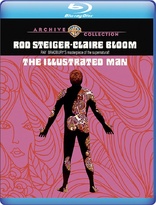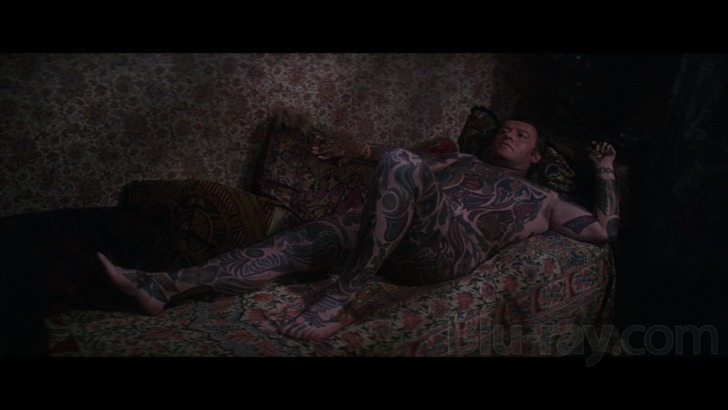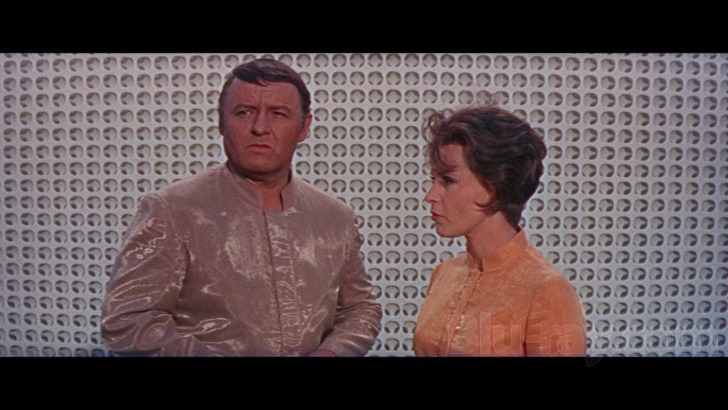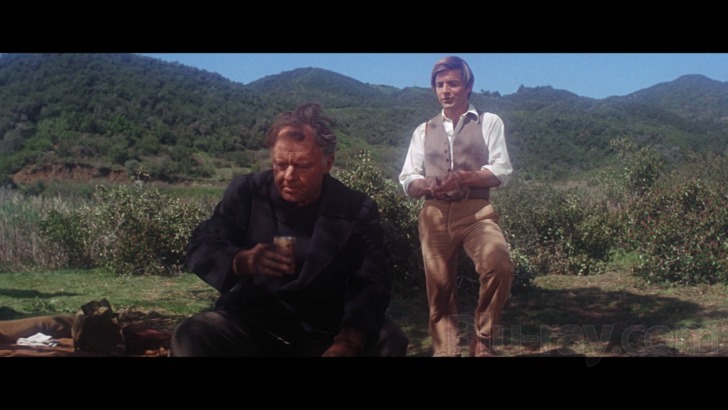The Illustrated Man Blu-ray Movie
HomeThe Illustrated Man Blu-ray Movie 
Warner Bros. | 1969 | 103 min | Rated PG | Sep 19, 2017
Movie rating
6.5 | / 10 |
Blu-ray rating
| Users | 0.0 | |
| Reviewer | 2.0 | |
| Overall | 2.0 |
Overview
The Illustrated Man (1969)
A good-natured drifter meets a tattooed man whose "skin illustrations" inspire terrifying visions.
Starring: Rod Steiger, Claire Bloom, Robert Drivas, Don Dubbins, Jason EversDirector: Jack Smight
| Sci-Fi | Insignificant |
| Mystery | Insignificant |
Specifications
Video
Video codec: MPEG-4 AVC
Video resolution: 1080p
Aspect ratio: 2.40:1
Original aspect ratio: 2.35:1
Audio
English: DTS-HD Master Audio 2.0 Mono (48kHz, 24-bit)
Subtitles
English SDH
Discs
Blu-ray Disc
Single disc (1 BD)
Playback
Region A, B (C untested)
Review
Rating summary
| Movie | 1.5 | |
| Video | 4.0 | |
| Audio | 4.0 | |
| Extras | 0.5 | |
| Overall | 2.0 |
The Illustrated Man Blu-ray Movie Review
The Future Isn't What It Used to Be
Reviewed by Michael Reuben September 19, 2017The Illustrated Man is based on three of the eighteen short stories from Ray Bradbury's collection of the same name. The stories, along with Bradbury's framing device, were bludgeoned into a script by Howard B. Kreitsek, who also produced. The film was directed by Jack Smight, who cast Rod Steiger in the title role after their successful collaboration on No Way to Treat a Lady, but neither the writer/producer nor the director had any notion of how to translate Bradbury's suggestive prose for the screen. The film flopped, and Bradbury condemned it (though he liked Steiger's performance). Fellow fantasy author (and Twilight Zone creator) Rod Serling pronounced it one of the worst movies ever made. Still, The Illustrated Man has gathered a following over the years. Fans who remember the film fondly from late-night TV screenings can now renew their acquaintance in this superior Blu-ray presentation from the Warner Archive Collection.

Kreitsek's script expands Bradbury's framing device of a man (Steiger) whose entire body is covered in tattoos—or, as he insists they be called, "skin illustrations". He gives his name as Carl, appearing out of nowhere in an isolated country location, where he accosts a young traveler named Willie (Robert Drivas, Cool Hand Luke). Alternately pitiful and menacing, Carl tells the story of how he acquired his tattoos at the hands of a mysterious woman, Felicia (Claire Bloom), who Carl says had traveled into both the future and the past and who, after completing his tattoos, disappeared back into the future. Now Carl wants to find her and kill her for having cursed him with ink that comes alive when people look into it too deeply.
The art on Carl's body gives Willie three visions based on Bradbury's story, all of them set in the future and all of them featuring Carl and Felicia (and sometimes Willie) in alternate identities. In the first, Carl and Felicia are parents arguing over whether to allow their children to continue playing in a simulator room that's eerily predictive of Star Trek's holodeck, where the kids have re-created an African veldt complete with lions and vultures. In the second, Carl leads a group of survivors of a spaceship crash on an unidentified planet where the rain is perpetual and survival depends on finding a "sun pod". (In Bradbury's story, the planet was Venus.) In the third, humanity's remaining population decides to self-terminate in advance of a looming extinction-level event, but Felicia can't accept Carl's decision to kill their children with sleeping pills.
Steiger received his usual bad reviews for "scenery chewing", but what he's really trying to do is inject life into an inert creation that has been both underwritten and misdirected. Kreitsek's script mistakes confusion for mystery, repeatedly setting up elaborate scenarios and then abandoning them just at the point where something interesting seems poised to happen. Smight's direction relies heavily on prolonged shots that are meant to be portentous but typically lead nowhere. The most effective passages are the flashbacks to Carl's interactions with the mysterious Felicia, in large part because Bloom underplays the character with a measured stillness that aptly conveys the woman's allure and quiet menace. These sections of the film also benefit from containing the most extensive display of the body art applied to Steiger from neck to toe, which is the subject of a short featurette in the extras. They're a remarkable creation, especially when we see Carl in Felicia's den, where the tattoos seem to bleed into the decor.
But the filmmakers' creativity seems to have been exhausted with Carl's "skin illustrations". Their visions of the future are a vaguely realized mush of elements warmed over from 2001 and Planet of the Apes, both of which had been released the previous year. The present day sequences consist of little more than aiming the camera at Willie and Carl in an idyllic setting, while Steiger works up a sweat (literally) in an effort to create drama. Drivas' Willie looks alternately horrified and fascinated, but when his encounter with the tattooed man ultimately erupts in violence, it doesn't feel like a conclusion or a resolution, just the latest in a series of random events.
The Illustrated Man Blu-ray Movie, Video Quality 

The Illustrated Man was shot in anamorphic Panavision by Philip Lathrop (Earthquake and The Americanization of Emily). For this 1080p, AVC-encoded Blu-ray from the Warner Archive Collection, a recent interpositive was scanned at 2K by Warner's Motion Picture Imaging facility, followed by color-correction using a dye-transfer Technicolor print as a reference. After WAC's typically thorough clean-up to eliminate dust, scratches and age-related wear, the resulting image is impressively detailed and vibrantly colorful, effectively rendering the film's diverse settings, which vary from the richly dark decor of Felicia's den to the sterile future depicted in Willie's visions. Day-for-night sequences exhibit the fall-off in detail that is typical of that process, and scenes set in the future are distinguished by softening with diffusion and colors that are deliberately odd and unnatural. The grain pattern is finely resolved, and the image is free of artifacts or distortion (other than the unavoidable side effects of optical superimposition, e.g., during the title sequence). WAC has mastered The Illustrated Man at its usual high bitrate of just under 35 Mbps.
The Illustrated Man Blu-ray Movie, Audio Quality 

The film's mono soundtrack has been taken from the magnetic master, cleaned of any age-related distortion and encoded on Blu-ray in lossless DTS-HD MA 2.0. It's a robust track with broad dynamic range, of which the chief beneficiary is the electronic score by the legendary Jerry Goldsmith (Alien, Total Recall and most of the pre-reboot Star Trek films, among many others). Goldsmith's oddly timed beats, clangs and thuds contribute most of whatever suspense The Illustrated Man is able to generate. His score deserved a better film.
The Illustrated Man Blu-ray Movie, Special Features and Extras 

The extras have been ported over from Warner's 2006 DVD of The Illustrated Man:
- Tattooed Steiger (480i; 1.33:1; 9:46): This vintage featurette focuses on the design and application of Carl's "skin illustrations". It also contains a brief scene of the cast at what appears to be a table read.
- Trailer (1080p; 2.40:1; 2:56): Once you've seen the film, the trailer seems almost comical in its efforts to promote it as a horror movie.
The Illustrated Man Blu-ray Movie, Overall Score and Recommendation 

Watching The Illustrated Man on this Blu-ray was the first time I have ever seen the film in its
entirety. It didn't win me over, and I suspect most first-time viewers will have the same reaction,
regardless of whether they know Bradbury's original short stories. But fans who remember the
film fondly should enjoy this vivid presentation of its languid and loopy imagery, and for them
the disc is recommended. For all others, approach with caution.
Similar titles
Similar titles you might also like

On the Beach
1959

The Satan Bug
1965

Unforgettable
1996

Conquest of Space
1955

The Mystery of Mr. Wong
1939

Cover Up
1949

Panic in Year Zero
End of the World / Survival
1962

The World, the Flesh and the Devil
Warner Archive Collection
1959

Narcopolis
2015

Mr. Wong in Chinatown
1939

The Drowning Pool
1975

Coma
1978

The Chalk Garden
1964

The Three Faces of Eve
Fox Studio Classics
1957

Mirage
1965

Skullduggery
1970

The Spiral Staircase
1946

Soylent Green
1973

Strange Days
1995

The Day the Earth Caught Fire
1961